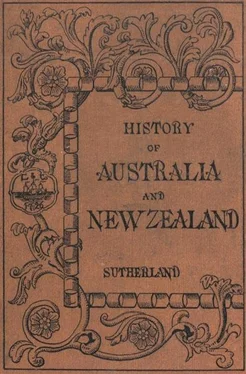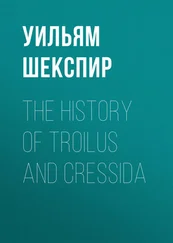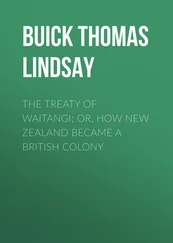3. Copper.—At the Kapunda Station, about forty miles north-west of Adelaide, there lived a squatter named Captain Bagot. One day, during the year 1842, he sent his overseer—Mr. Dutton—to search for a number of sheep which had strayed into the bush. After spending some time in fruitless efforts, Mr. Dutton ascended a small hill in order to have a more extensive view of the country, but still he saw nothing of the lost sheep. On turning to descend, his attention was attracted by a bright green rock jutting from the earth. It seemed to him peculiar, so he broke a small piece off and carried it down to Captain Bagot’s house, where he and the captain examined the specimen, and came to the conclusion that it consisted of the mineral malachite, containing copper in combination with water and carbonic dioxide. They let no one know of the discovery, but proceeded to apply for the land in the usual manner, without breathing a word as to their purpose. The section of eighty acres was advertised for a month, and then put up to auction; but as no one was anxious for this barren piece of ground, they had no competitors, and the land fell to them for the price of eighty pounds. As soon as they became possessed of it, they threw off all appearance of mystery, and commenced operations. During the first year the mines yielded £4,000; during the next, £10,000; and for several years they continued to enrich the two proprietors, until each had realised a handsome fortune, when the land was bought by an English company.
4. The Burra Mines.—The discovery of copper at Kapunda caused much excitement in the colony. Every one who possessed land examined it carefully for the trace of any minerals it might contain; and soon it was rumoured that, at a place about one hundred miles north of Adelaide, a shepherd had found exceedingly rich specimens of copper ore. The land on which these were discovered had not yet been sold by the Government, and in great haste a company was formed to purchase it. This company consisted of the merchants, professional men, and officials of Adelaide; but a rival company was immediately started, consisting of shopkeepers and tradesmen, together with the farmers of the country districts. The former always maintained a haughty air, and soon came to be known throughout the colony as the “nobs”; while they, in their turn, fixed on their rivals the nickname of the “snobs”. For a week or two the jealousies of the companies ran high, but they were soon forced to make a temporary union; for, according to the land laws of the colony, if any one wished to buy a piece of land, he had to apply for it and have it advertised for a month; it was then put up for auction, and he who offered the highest price became the purchaser. But a month was a long time to wait, and it was rumoured that a number of speculators were on their way from Sydney to offer a large sum for the land, as soon as it should be put up to auction. It was, therefore, necessary to take immediate action. There was another regulation in the land laws, according to which, if a person applied for 20,000 acres, and paid down £20,000 in cash, he became at once the proprietor of the land. The “nobs” determined to avail themselves of this arrangement; but when they put their money together, they found they had not enough to pay so large a sum. They therefore asked the “snobs” to join them, on the understanding that, after the land had been purchased, the two companies would make a fair division. By uniting their funds they raised the required amount, and proceeded with great exultation to lodge the money. But part of it was in the form of bills on the Adelaide banks; and as the Governor refused to accept anything but cash, the companies were almost in despair, until a few active members hunted up their friends in Adelaide, and succeeded in borrowing the number of sovereigns required to make up the deficiency. The money was paid into the Treasury, the two companies were the possessors of the land, and the Sydney speculators arrived a few days too late.
Now came the division of the 20,000 acres. A line was drawn across the middle; a coin was tossed up to decide which of the two should have the first choice, and fortune favoured the “snobs,” who selected the northern half, called by the natives Burra Burra. To the southern part the “nobs” gave the name of “Princess Royal”. The companies soon began operations; but though the two districts appeared on the surface to be of almost equal promise, yet, on being laid open, the Princess Royal was soon found to be in reality poor, while the Burra Burra mines provided fortunes for each of the fortunate “snobs”. During the three years after their discovery they yielded copper to the value of £700,000. Miners were brought from England, and a town of about 5,000 inhabitants rapidly sprang into existence. The houses of the Cornish miners were of a peculiar kind. A creek runs through the district, with high precipitous banks of solid rock; into the face of these cliffs the miners cut large chambers to serve for dwellings; holes bored through the rock, and emerging upon the surface of the ground above, formed the chimneys, which were capped by small beer barrels instead of chimney-pots. The fronts of the houses were of weatherboard, in which doors were left; and for two miles along each side of the stream these primitive dwellings looked out upon the almost dry bed of the creek, which formed the main street of the village. Here the miners dwelt for years, until the waters rose one night into a foaming flood, which destroyed the houses and swept away several of their inhabitants.
In 1845 Burra Burra was a lonely moor; in 1850 it was bustling with men, and noisy with the sounds of engines, pumps and forges. Acres of land were covered with the company’s warehouses and offices, and the handsome residences of its officers; behind these there rose great mounds of blue, green, and dark-red ores of copper, worth enormous sums of money. Along the roads eight hundred teams, each consisting of eight bullocks, passed constantly to and fro, whilst scores of ships were employed in conveying the ore to England. From this great activity the whole community could not but derive the utmost benefit, and for a time South Australia had every prospect of taking the foremost place among the colonies.
5. Governor Robe.—In 1841 Governor Grey had been of the greatest service to the colony in changing the state of its prospects, but he was not permitted to see more than the commencement of its great prosperity; for, in 1845, he was sent to govern New Zealand, where troubles had arisen similar to those which he had helped to cure in South Australia. His place was filled by Colonel Robe, a military gentleman, of what is called the old school, honourable and upright, but inclined to think that everything ought always to be as it has been. He disliked all innovation, and did what he could to prevent it, much to the discontent of the young and thriving colony, which was of necessity the scene of constant and rapid changes. He passed a very troublous time for three years, and in 1848 was heartily glad to be recalled.
6. Governor Young.—The colony was then placed under the care of Sir Henry Young, whose policy was completely the reverse. He sought by every means in his power to encourage the ceaseless activity of the people. His failing was, perhaps, an injudicious zeal for progress. For instance, in his desire to open up the river Murray to navigation, he wasted large sums of money in schemes that proved altogether useless. He made an effort to remove the bar at the mouth of the river, but fresh deposits of sand were constantly being brought down by the current, and lashed up into a new bar by the waves that rolled ceaselessly in from the Southern Ocean. He spent about £20,000 in trying to construct a harbour called Port Elliot, near the entrance to the Murray; but there are now only a few surf-beaten stones to indicate the scene of his fruitless attempt. He offered a bonus of £4,000 to the first person who should ascend the Murray in an iron steamer as far as the river Darling. A gentleman called Cadell made the effort, and succeeded; he obtained the reward, but it was not enough to pay his heavy expenses, and when he endeavoured afterwards to carry on a trade, by transporting wool to the sea in flat-bottomed steamers, he found that the traffic on the river was not sufficiently great to repay his heavy outlay, and in a short time he was almost ruined. The attempt was premature; and though, in our time, the navigation of the Murray is successfully carried on, and is, undoubtedly, of immense advantage not only to South Australia, but also to New South Wales and Victoria, yet, at the time when the first efforts were made, it led to nothing but loss, if not ruin to the pioneers.
Читать дальше












